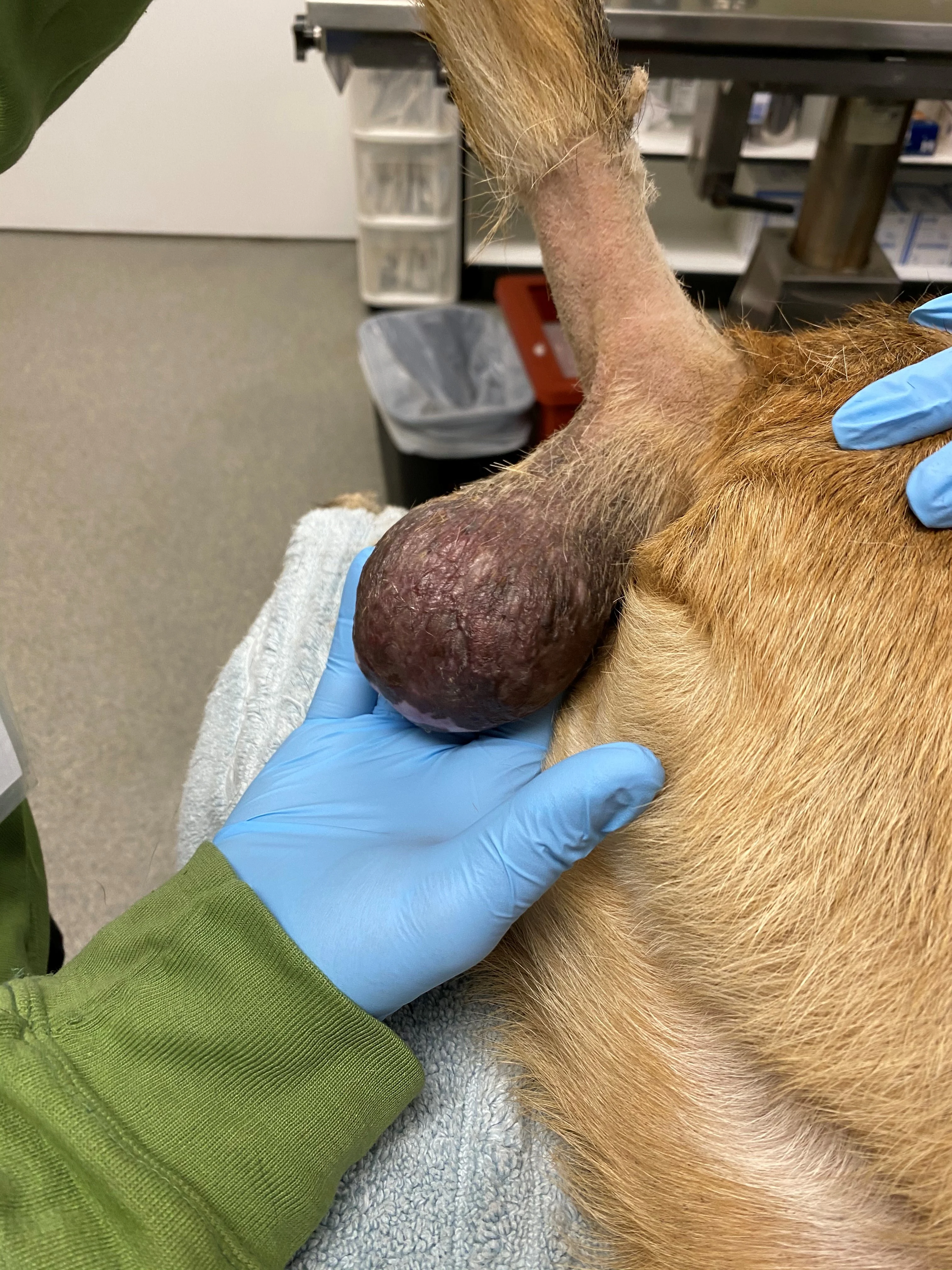Pedunculated Tail Mass in a Hound
Conor Williams, DVM, Purdue University
Alyssa Comroe, DVM, MPH, Peggy Adams Animal Rescue League, West Palm Beach, Florida
Lisa M. Pohlman, DVM, MS, DACVP, Kansas State University

An ≈8-year-old, 50.3-lb (22.8-kg) neutered male hound crossbreed was presented to a shelter after being found as a stray. Distemper/adenovirus/parainfluenza/parvovirus and rabies vaccinations, heartworm testing, and topical imidacloprid + moxidectin for parasite control were administered on intake; heartworm antigen test was negative.
Physical Examination
The only significant abnormality identified on physical examination was a large (15 x 6 cm), pedunculated, firm mass on the ventral tail (close to the base; Figure 1). Cytologic samples were collected via fine-needle aspiration, and stained slides were evaluated by a clinical pathologist.
Cytology
Cytologic assessment (Figures 2 and 3) resulted in diagnosis of perianal gland neoplasia (ie, hepatoid tumor). Excisional biopsy with histopathology was recommended to determine whether the tumor was malignant or benign. Tumor staging via thoracic radiography, abdominal radiography, and abdominal ultrasonography were considered but not performed due to owner financial constraints.

Figure 1
Large, pedunculated, firm mass visible on the ventral tail
HISTOPATHALOGIC DIAGNOSIS:
PERIANAL GLAND ADENOMA
Treatment
Maropitant (1 mg/kg SC) was administered 30 minutes before premedication with hydromorphone (0.1 mg/kg IV). The patient was anesthetized with of a mixture of tiletamine/zolazepam, butorphanol, and dexmedetomidine (0.56 mL IV), a common anesthetic protocol used in shelter medicine.<sup1 sup>
An elliptical incision was made around the base of the mass. Blunt dissection was used to remove the mass from subcutaneous tissue and away from the area of attachment. The incision was closed using 3-0 polydioxanone suture in a continuous pattern in the subcutaneous and subcuticular layers. Skin sutures were placed using 2-0 polydioxanone suture in a cruciate pattern. Meloxicam (0.18 mg/kg SC) was administered immediately postoperatively.
The mass was placed in neutral-buffered 10% formalin and submitted for histopathologic evaluation, which confirmed diagnosis of perianal gland adenoma.
Postoperative recovery was uneventful. An Elizabethan collar was placed, and the incision was inspected at least every 12 hours because of its proximity to the anus (Figure 4). Meloxicam (0.08 mg/kg PO every 24 hours for 5 days), gabapentin (13 mg/kg PO every 12 hours for 5 days), and trazodone (6.6 mg/kg PO every 12 hours for 10 days) were prescribed.
TREATMENT AT A GLANCE
Surgical resection is considered the mainstay treatment for neutered male and spayed dogs with perianal gland adenomas.13
Neutering and surgical resection are the recommended treatments for perianal gland adenomas in intact male dogs.13 Neutering is recommended to remove the androgenic stimulation; tumors shrink and facilitate surgical excision as testosterone concentrations decline.6,13
Outcome
The surgical site healed uneventfully, and the sutures and Elizabethan collar were removed 10 days postoperatively. The dog was adopted shortly thereafter, and follow-up indicated he continued to do well.
Discussion
In dogs, perianal glands (ie, circumanal or hepatoid glands; hepatoid refers to the histologic/cytologic resemblance of cells to hepatocytes) are modified sebaceous glands located circumferentially around the anus; on the skin of the prepuce, perineum, tail, and pelvic limbs; and along the dorsal or ventral midline as far cranial as the neck.2-4 These glands (and their associated tumors) occur only in dogs and should not be confused with anal glands/sacs present in multiple species.
The 3 types of perianal gland tumors are perianal gland adenomas, epitheliomas, and perianal gland adenocarcinomas.2 Of these, perianal gland adenomas are most common, comprising >80% of all perianal gland tumors and ranking third among the most frequently diagnosed tumors in male dogs.5 Predisposed breeds include cocker spaniels, poodles, schnauzers, beagles, English bulldogs, Siberian huskies, Samoyeds, and crossbreed dogs.<sup4,6,7 sup>
Perianal gland adenomas are most commonly found on the skin (typically circumferentially around the anus but can be in any location where there are perianal glands) and are benign, typically slow-growing tumors that can be single or multiple, nodular or multinodular, ulcerative, and/or infected.<sup4,6,8 sup>
On cytology, perianal gland adenomas have a predominant population of large, cuboidal- to polygonal-shaped epithelial cells found in cohesive cell clusters with granular, pink–blue cytoplasm. Nuclei are round, usually single, with distinct nucleoli. Cellular pleomorphism is minimal.3 Varying numbers of reserve (basaloid) cells are also typically present, but the proportion of reserve cells is not an indicator of biological behavior.9 Tumors predominantly composed of reserve cells (>90%) are classified as epitheliomas.8
Pathogenesis and occurrence of perianal gland adenomas are not completely understood and appear multifactorial. Development and progression are dependent on sex hormones.6,7 Intact male dogs ≥8 years of age are at increased risk.4,6,7 Spayed dogs are also at significantly greater risk compared with intact female dogs.10 Androgen and estrogen may be both deleterious and protective, respectively, in etiology.10 Perianal gland adenomas often fully or partially regress (≤95% of cases) following neuter, indicating the influence of testosterone on these tumors.4,11,12
A presumptive diagnosis of perianal gland tumor can often be made based on signalment, patient history, and physical examination findings, especially when the tumor is located in the hairless perianal skin, a common location for this tumor type.6 Fine-needle aspiration of the mass and subsequent cytologic examination can support diagnosis and help rule out other tumors (eg, anal sac adenocarcinoma, inflammatory lesions).6
Cytology typically does not help differentiate between benign and malignant perianal gland tumors (ie, perianal gland adenoma vs perianal gland adenocarcinoma) because perianal adenocarcinomas can be either well or poorly differentiated.2 Incisional or excisional biopsy with histopathology is typically recommended to determine the biological behavior of the tumor.2,6
Neutering and surgical resection are the recommended treatments for perianal gland adenomas.13 Staged surgery may be preferable, and neutering is recommended to remove the androgenic stimulation in patients with large tumors. Tumors shrink and facilitate surgical excision as testosterone concentrations decline.6,13 Neutering does not lead to resolution or regression of perianal gland adenocarcinoma in intact male dogs.2
Alternate treatments (eg, cryosurgery, carbon dioxide laser ablation, electrochemotherapy, estrogen therapy, cyclosporine) for perianal gland adenoma management can have varying results.6,14,15
TAKE-HOME MESSAGES
Perianal gland adenomas can develop in any location with perianal glands, including in the skin around the anus, prepuce, perineum, tail, and pelvic limbs, as well as along the dorsal or ventral midline as far cranial as the neck.2-4
Perianal gland adenomas are benign, typically slow-growing tumors with the potential to ulcerate and become infected.4,8,14
Perianal gland adenoma occurrence is related to androgenic hormones. Older, intact males and spayed females have a significantly higher risk for tumor development.4,6,7,10
Perianal tumors have cytologic features typically sufficient for diagnosis of cellular origin, but histopathology is often necessary to determine biological behavior and differentiate benign and malignant lesions, as both well- and poorly differentiated adenocarcinomas can occur.2,6
Perianal gland adenomas often fully or partially regress (≤95% of cases) after neuter, indicating the influence of testosterone on these tumors.4,11,12
Neutering does not lead to resolution or regression of perianal gland adenocarcinomas in intact male dogs.2